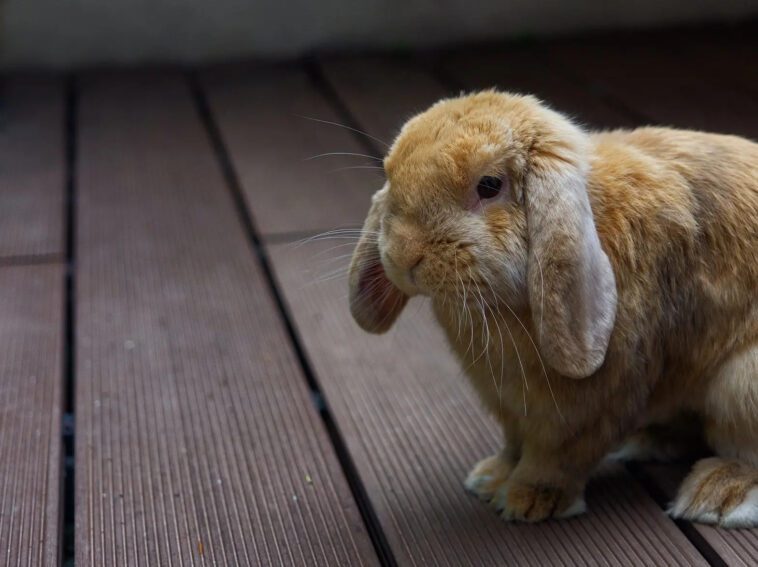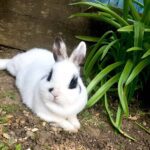Similar to other animals, your rabbit’s poop has more meaning than the fact they are just digesting their food. From its texture, color, and shape, it will help you identify if your pet is in good condition or not. It can tell if they are drinking enough water or if your diet plan is suitable for their metabolism.
Also, your pet’s poop can assist veterinarians in diagnosing some underlying illnesses in rabbits, especially if it involves digestive problems.
Therefore, as a pet owner, you need to understand that your rabbit’s poop should be checked hand in hand to ensure that they are healthy and not experiencing any issues.
Understanding Rabbit Poop
To determine whether your rabbit is healthy or has underlying digestive issues, you must first understand what normal rabbit poop looks like. According to Supreme Pet food, rabbits poop at least 200-300 pieces of pellets daily. Normally, their poop stool should be round and uniform in size. At the same time, the color varies from light to dark brown.
Normal poop is also slightly moist, especially when your pet just pooped a minute ago.
However, it should be able to dry out quickly. And when you touch it, it should crumble easily with noticeable pieces of undigested fiber from their diet meals.
However, if the poop is very dark in color and the shape is quite irregular, it might suggest that your rabbit cannot process adequate fiber.
And if you think your rabbit is not pooping for a while, even after eating their food. Then you must visit the veterinarian since its digestive tract may have potentially stopped processing the food they eat.
Types of Rabbit Poop
Cecotrope
The first type of rabbit poop is called Cecotrope. You will determine this type of poop easily because your rabbit will eat this stool. Although this is not normal for other pets, it is essential for your rabbit’s health to nibble the Cecotrope directly from its bottom.
The poop of Cecotrope contains additional nutrients that your pet needs, such as vitamins and proteins than their other fecal pellet. And because it is also part of their system, they have the instinct to munch on these poop pellets. This habit is natural for them, particularly during the morning after their meal or late at night.
For the texture, cecotropes look like sticky pellets usually gathered together like a vine grape. The color is darker, shiny, and possibly tasty, as rabbits can’t get enough of them.
However, you may not detect the presence of cecotropes poop in your rabbit’s cages because they eat the pellet stool as soon as they are excreting them.
One of the noticeable signs for your rabbit, when they are about to eat their fecal, is they are seemingly cleaning or licking their anal area. When this occurs, the rabbits are preparing to catch the cecotropes.
Fecal pellets
The second type of Rabbit poop is called Fecal pellets. This stool is a hard-like texture and is round in shape pellets. It also has a noticeable presence of hay fibers and other debris-like parts. They are moist when they first come out but can easily dry. When you carefully examine and touch the poop, it may break and easily crumble.
Moreover, the normal fecal pellets look like round balls with dark to light brown or beige in color and are fair in size.
This poop is more commonly seen in the litter box in the area around it than in the Cecotrope because rabbits do not digest this poop.
Types of Poop Droppings
Small and Round Shape Droppings
The rabbit’s droppings may become small for several reasons, such as stress. Your rabbit is known as a sensitive animal. They can get stressed by just hearing the loud noises or separation anxiety.
When this occurs, your pet can suddenly drop a small size of poop because they are scared.
However, you don’t have to worry because their poop will normally go back to the usual size when they are in good condition after a few hours.
But, if you notice that your rabbit is continuously dropping a small fecal size, it might indicate health problems such as chronic pain or a temporary blockage inside the intestine. It is best to consult your doctor and get a fecal test to provide treatment.
Large and Egg-like Shaped Droppings
Large and egg-like shape droppings are a result of a megacolon. This occurs because your rabbit might get this from their genotypes. Although sometimes stress and trauma also affect the shape of their droppings.
Having this shaped from your rabbit poop is unusual, and if you feel your pet has it, you may take them to the vet for peace of mind and diagnose your rabbit properly.
Doubles and Single Droppings
Normal poop for rabbits should be uniform in size and link to each other. A double or single formation of droppings suggested that something was wrong with their digestion.
Most cases of irregular poop shape can be caused due to stress or maybe because they eat food unsuitable for their diet. So when your pet rabbit is beginning to drop more doubles and singles each day which is unusual for them, drop by the local vet and ask for medication to get their poop back in normal shape.
Droppings that Look like Link by Hair
If you notice poop with a presence of hair or fur linked in your pet’s stool, you should not worry about it. Droppings with this kind of texture and appearance are normal to any rabbit. This also indicates that your pet is healthy and has good digestive function.
High-in fiber food such as hays and rabbit pellets cause their poop to form a texture of strands that link in their poop after they excrete them. However, doctors may suggest adding more nutritional foods like greens and fruits to help your pet develop a stronger body and to maintain a good poop texture.
Droppings that have Mucus
The presence of Mucus in your rabbit’s droppings is not normal. The Mucus might indicate irritation from their digestive function.
On the other side, your pet might also get mucus lining in their poop if it is medicated with antibiotics. However, asking your doctor about this is the best option that you should do to make sure it will not escalate into further problems in your rabbit’s life.
Soft and Watery Droppings
The soft and watery texture of your rabbit’s droppings indicates serious problems. Their poop should have a consistent shape and texture, which is round and firm.
This kind of poop might be caused by infection or some parasitic attack in the rabbit’s stomach. However, in some cases, your diet for them can also contribute to the texture of their poop. The foods might not be suitable for their digestive system.
To have a better understanding and visual reference for the poop’s appearance and shape, you can always conduct research or ask your veterinarian about this matter. This will help you easily identify if nothing is wrong with their droppings or if it’s time for you to ask for expert advice from your pet’s doctor.
Common Reasons That Affect Rabbits’ Poop
Diarrhea
Rabbit diarrhea is an alarming situation for your rabbit pet. Since your rabbit is known to have a different way of metabolizing food, they are the type of animals that are susceptible to diarrhea.
Also, according to a report from VCA Animals, diarrhea is one of the signs of gastrointestinal disease in rabbits, which is an alarming health risk for any rabbit’s life.
Another reason for diarrhea is exposure to poisonous toxins from their food.
To know more about the food that your rabbit can and cannot eat, read this article:
The Definitive Guide To What Foods Rabbits Can & Cannot Eat.
Cecal Dysbiosis
Cecal Dysbiosis affects your rabbit poop because of the disruption in their digestive tract. This dropping can also be due to stress in their surroundings or signs of illness.
Your rabbit can easily develop this health risk, especially if your diet for your pet is full of starch, sugar, and carbohydrates, which they cannot digest well.
If you are planning to introduce food to them, have a proper transition for them to adjust to the nutrient content of the food. After this, You can wait for the next droppings of your pet and keep an eye on if there are any changes.
You should always observe your rabbits showing illness after pooping with dysbiosis because it might threaten more serious health issues. Most especially older rabbits that have dysbiosis. They are more vulnerable to experiencing painful joints and disrupted digestive tracts.
Parasites
Commonly, veterinarians test for a parasitic infestation in your rabbit’s stomach and poop when a rabbit owner is experiencing irregular droppings from their pet.
That is because droppings infested by parasites such as worms and tapeworms in the rabbit’s gastrointestinal tract are considered to affect their metabolism process, causing Mucus and watery stool for your pet.
An early case of parasitic infestation should be treated immediately to not cause further problems to your rabbit. However, in case of severe infestation, you should expect some health risks for your rabbits, such as malnutrition, diarrhea, and severe pain from their stomach lining.
Tips for Healthy Rabbit Poop
Plan a Balanced Diet
One simple way to guide your pet on producing a healthy poop is to plan a balanced diet. After all, what they poop is what they eat.
Rabbit’s diet mostly fodders in a rich-fiber meal such as hay. Although it’s not bad for them to eat other food like veggies, it’s best to always keep an eye on them when introducing them to food. If there are any changes in their poop texture, kindly remove the food immediately on their staple.
Provide Fresh Water
Water is an important factor in your rabbit’s digestion. Aside from keeping them hydrated, drinking water helps them from absorbing the food to their stomach up to excreting their stool. Increasing water intake can help your pet make more soft poop and will also help dilute your pet’s system.
That is why regularly changing your pet’s water bowl is important to ensure you provide fresh and clean drinking water. This will also prevent the growth of bacteria in the water.
Ask for Professional medical assistance.
Find a reliable and trusted local veterinarian for your rabbit. Their assistance can help you provide your pet with a good and healthy life. Although you are not suspecting any illness from them, it is best to have a scheduled check-up because there may be an underlying disease that does not show any symptoms.
Cleaning Rabbit Poop
Keeping the litter box or rabbit cage is as important as your rabbit’s hygiene. That is because potential bacteria may grow in their cage and threaten your rabbit. For example, a fly will be attracted to your rabbit poop; this will also open up an opportunity for them to lay their egg and become larvae. So how should you clean your rabbit poop?
Nowadays, there are now available cleaning products for pet’s stools. Regularly spray and remove your rabbit’s droppings to sanitize the litter box. However, ensure that the cleaning product does not contain an ingredient that can irritate your rabbit. According to the University of California, rabbits are very sensitive to smells like chemicals.
If you want a more natural method of cleaning your rabbit’s poop, you can use plain soap, vinegar, and water to remove the foul smell and kill other common bacteria.
Uses of Rabbit’s Poop
Rabbits Poop as a Fertilizer
Using your rabbit poop as a fertilizer is a good option for you instead of dumping it elsewhere. This practice gives a list of benefits for you and your garden because rabbit poop provides more nutrients than other animal poop. You can also use their poop to compost, enriching your garden soil and the plants there.
If you are worried that it will become smelly, you don’t need to think of that. Healthy poop is often odorless since rabbits are fed with hay and grass.
Rabbit Poop as a Compost Tea
Another use you can take advantage of for your rabbit poop is making compost tea, unlike the common composting process that takes a few days for the poop to decompose completely. Compost tea is easier to make.
Water and poop is the only thing you need. Mix them until all the poop is dissolved; after this, you can pour the compost tea on your garden soil and plants.
Rabbit Poop Key Takeaways
- The rabbit’s poop texture, color, and shape indicate their overall health and digestion.
- Normally, a healthy rabbit poops around 200-300 droppings every day. They are round and uniform in size and have a color that varies from light to dark brown.
- There are two types of Rabbit poop, Cecotrope, and fecal pellets. Cecotrope is the type of poop your rabbit can eat because it contains additional nutrients for its body. On the other hand, fecal pellets are regular poop with a notable fiber texture in their stool.
- There are several types of poop droppings from your rabbit. Small and round shape, Large and egg-like shape, Double droppings, Linking to hair droppings, Mucus droppings, and Watery texture poop. All of this signifies important information about your rabbit’s condition.
- Diarrhea causes your rabbit’s poop to become soft because of either an upset stomach or because they become stressed in their surroundings. There are studies that diarrhea is also one of the clinical symptoms of gastrointestinal illness, which is a big threat to your rabbit’s life.
- Cecal Dysbiosis affects your rabbit poop because of the disruption in their digestive tract. One of the common reasons for your rabbit to experience this is improper nutrition, such as too much intake of unwanted fats and starch.
- Parasitic infestation also contributes to your rabbit’s pooping activity. Since the bacteria or parasites such as tapeworms attack the stomach lining and get the nutrients your rabbit needs, it results in a bad texture of their poop.
- You should remember three tips for your rabbit to have a healthy-looking poop. First, plan a balanced diet suitable for your pet’s digestion. Second, always provide fresh and clean water for them to drink regularly. And third, ask a veterinarian for assistance in caring for your rabbit, especially with their health and wellness.
- Cleaning your rabbit’s litter box and cage is important hygiene that you should practice. You can use pet cleaning products to sanitize the area or for a more natural method, try using regular soap, vinegar, and water.
- You can take advantage of your pet’s stool, like using it as a fertilizer and making a compost tea for your garden soil.
Related Content
Rabbit Diet
- The Definitive Guide To What Foods Rabbits Can & Cannot Eat
- 6 Rabbit Pellets You Can Trust
- Do Rabbits Love Sweet Foods? (Natural Treats & Feeding Guide)
- Best Treats To Reward Your Rabbits (Feeding Guide & Tips)
- What Food Do Baby Bunnies Eat? (Ideal Diet & Care Guide)
- How Long Can Rabbits Survive Without Food? (Survival Rate, Facts & Care Guide)
- What To Do When Your Rabbit Accidentally Eats Marijuana? (The Law, Signs, Treatment & Alternatives)
Rabbit Health
- Definitive Guide to Your Rabbit’s Health
- Diarrhea In Rabbits: Causes, Treatment & Prevention
- Understanding the Drinking Habit of a Rabbit
- Rabbit’s Digestive System: Parts, Problems, Treatment & Prevention
- Lumps In Rabbits (Causes, Types, & Treatment)
- Understanding Your Rabbit’s Eyes: Common Infections (And Treatment)
- Ear Mites in Rabbits: Diagnosing, Risks, Prevention & Treatment
- Parasitic Infestation: Encephalitozoon Cuniculi in Rabbits (What It Is, Symptoms & Treatment)
- Rabbit Testicles: Common Problems, Symptoms & Best Practices


